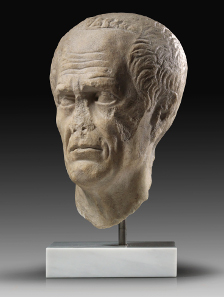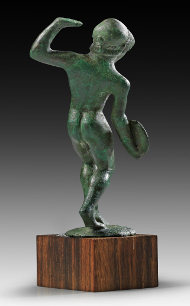24-06-2014 – 01-01-1970
Auction sale 222: Ancient Art
A contemporary portrait of Caesar is the highlight of auction sale Gorny & Mosch
Two auction sales of ancient art will be conducted by Gorny & Mosch on 25 and 26 June 2014. The first auction offers an interesting sample of all genres whose highlight is certainly a contemporary portrait of Caesar.
A single auction sale simply didn’t provide enough space for the abundance of material Gorny & Mosch is going to offer in its traditional auction sale in June. Hence, there are two sales this year: the first one to be conducted on 25 June, offering as usually an interesting sample of all material genres of the ancient world – with estimates ranging from 200 to 200,000 euros, and a second one on 26 June devoted entirely to ancient jewelry featuring in addition an impressive collection of gems, cameos and seals, dating not just to ancient times. You can read an auction preview of the jewelry sale here.
The sale starts with a small selection of works of Cycladic art, including a Cycladic violin idol, published several times, from the Nicolas Landau Collection (Lot 2; estimate: 30,000 euros).
10: Portrait of Caius Julius Caesar, c. 40-20 B. C. White-grey marble probably from Asia Minor. Height: 30 cm. Estimate: 200,000 euros.
The highlight of the first day is a probably contemporary portrait of presumably the most famous Roman: Caius Julius Caesar (Lot 10; estimate: 200,000 euros). It depicts the ageing politician with all the veristic features so characteristic of the late Roman Republic: the receding hairline that is masked by the hair combed into the forehead, the wrinked neck, and the sunken cheeks. The portrait from the collection of Pierre Sciclounoff is highly likely to have belonged to an honorary statue once that had been erected for Caesar in the east of the empire.
Not too long after that, i.e. in the 1st cent. A. D., the life-size marble statue of an elegant Roman lady was produced, offered under lot no. 8 and coming with an estimate of 150,000 euros. She is wearing a tunica, a stola and a palla, which allows a dating since the stola became outmoded in the high empire.
7: Maenad. Roman Imperial times, late Antonine, 2nd half 2nd cent. A. D. Slightly grey mottled, slightly macrocristallyne marble. Height 88 cm. Estimate: 150,000 euros.
With considerably lighter garments comes the smaller than life-size statue of a vivaciously walking maenad (Lot 7; estimate: 150,000 euros), that was made in the second half of the second cent. A. D.
33: Discobolus. Etruscan, 2nd quarter 5th cent. B. C. Solid cast bronze. Height: 8 cm. Estimate: 55,000 euros.
The fans of sport are likely to admire the Etruscan bronze statuette of a discobolus, hence a discus thrower, carved in the second quarter of the 5th cent. B. C. (Lot 33; estimate: 55,000 euros). The only 8 centimeter high, prominently published work of art has a parallel piece in Berlin which was probably made in the same workshop. It is the most expensive item in the section ‘Bronze Sculpture’. Whether it stays that way can’t be said with certainty for there are several lots that have a good chance to exceed the discobolus thanks to their beauty. Candidates are a – its height of 8.5 centimeters notwithstanding – monumental head of Heracles from early imperial times (Lot 66; estimate: 20,000 euros) and a late Hellenistic mule head that bears testimony to the Greek artist’s fine nature observation (Lot 68; estimate: 20,000 euros). It will be exciting to see what a large Greek amphora-situla with lid from the second half of the 4th cent. B. C. will fetch. The piece, lavishly decorated with silver inlays, has parallels in the vessels found in the Derveni necropolis (Lot 83; estimate: 40,000 euros).
A Bronze helmet with protruding crest from Urartu or Assyria (Lot 87; estimate: 35,000 euros) and a Sasanid spangenhelm (Lot 88; estimate: 20,000 euros) bear witness to the fine handwork that was put into pieces of armor in antiquity.
Many more special objects would deserve mention here, be it from the large selection of Egyptian artworks, the Oriental department, pre- and early history, and the pre-Columbian art, but at this point a mere remark that there are many interesting pieces also available to the collector with a smaller budget will have to do. The 110 multiple lots in particular comprise many a magnificent testimony from the past at a price that is more than reasonable. Hence, a careful viewing will surely pay off.
The catalog can be viewed online.
Gorny & Mosch gladly provides you with a printed copy as well. Request your copy at Gorny & Mosch, Giessener Münzhandlung, Maximiliansplatz 20, D-80333 Munich, phone +49 / (0)89 / 24 22 643-0, fax +49 / (0)89 / 22 85 513. The next auction sale ‘Ancient Art’ is scheduled for December 2014. Consignments are accepted until September 2014.








